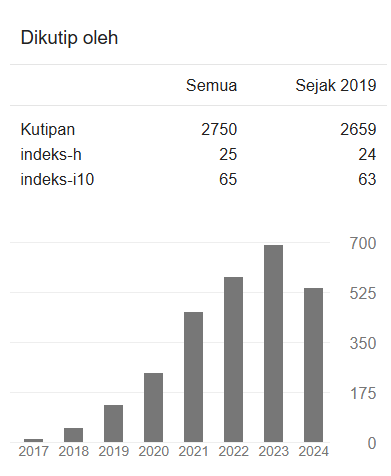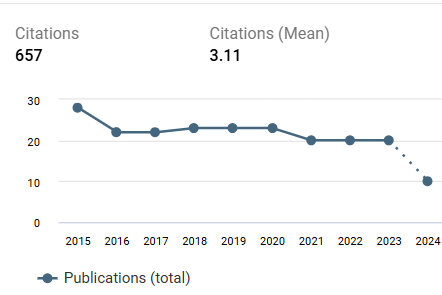REKOGNISI DALAM MEREPRESENTASIKAN SIMBOL TURUNAN PARSIAL SEBAGAI METONYMY DAN METAPHOR
DOI:
https://doi.org/10.22219/jinop.v5i2.9659Keywords:
representasi, simbol, turunan parsial, metonymy, metaphorAbstract
Representasi simbol melibatkan metonymy dan metaphor. Metonymy sebagai rantai penanda, dalam hal ini simbol, sedangkan metaphor sebagai pemaknaan dari penanda (simbol). Metonymy dan metaphor saling terkait dan terlibat dalam sistem penyimbolan saat seseorang menemukan simbol baru dalam proses pembelajaran matematika. Mahasiswa Teknik Sipil banyak menemukan simbol baru dalam perkuliahan Kalkulus II, seperti simbol fungsi dua variabel atau lebih beserta turunannya. Simbol-simbol tersebut tentunya berbeda dengan simbol fungsi satu variabel dan turunannya yang telah dipelajari pada Kalkulus I semester sebelumnya. Penelitian ini bertujuan untuk mendeskripsikan kemampuan mahasiswa Teknik Sipil dalam merepresentasikan simbol sebagai metonymy dan metaphor melalui penyelesaian masalah Turunan Parsial. Penelitian ini merupakan penelitian studi kasus, sebagai salah satu upaya untuk mendeteksi kesulitan mahasiswa dalam belajar Turunan Parsial. Mahasiswa diberi worksheet berisi masalah Turunan Parsial yang difokuskan pada representasi simbol sebagai metonymy dan metaphor. Hasil penyelesaian masalah pada worksheet dianalisis berdasarkan representasi simbol turunan parsial baik dari notasinya maupun makna dari notasi. Hasil yang diperoleh adalah bahwa mahasiswa Teknik Sipil kurang mampu dalam merepresentasikan simbol turunan parsial fungsi f terhadap x maupun y. Mahasiswa mampu menentukan selesaian akhir turunan parsial dengan benar, namun kurang baik dalam penandaan simbol turunan parsial.Downloads
References
Aguilar, F. J., dkk. 2014. Mathematical Symbol Hypotesis Recognition with Rejection Option. 14th Internationa Conference on Frontiers in Handwriting Recognition.
Astuti, E. P. 2017. Represntasi Matematis Mahasiswa Calon Guru dalam Menyelesaikan Masalah Matematika. Jurnal Tadris Matematika, 10 (1), 70-82. Mandasari, N. 2018. Elaborasi Kognitif dalam Proses Abstraksi Konsep Matematika. Makalah disajikan pada Seminar Nasional 21 Universitas PGRI Palembang, Palembang, tanggal 5 Mei.
Creswell, John. 2015. Riset Pendidikan: Perencanaan, Pelaksanaan, dan Evaluasi Riset Kualitatif dan Kuantitatif. Pustaka Pelajar: Yogyakarta.
Hutagaol, K. 2013. Pembelajaran Kontekstual untuk meningkatkan kemampuan representasi matematis siswa sekolah menengah pertama. Jurnal Ilmiah Program Studi Matematika STKIP Siliwangi Bandung INFINITY, 2 (1), 85-99.
Jitendra, A. K., dkk. 2016. Is Mathematical Representation of Problems an Evidence-Based Strategy for Students with Mathematics Difficulties?. Sage Journal, 83 (1), 8-25.
Leibovich, T. & Ansari, D. 2016. The Symbol-Grounding Problem in Numerical Cognition: A Review of Theory, Evidence, and Outstanding Questions. Canadian Journal of Experimental Psychology, 70 (1), 12-23.
Lestari, K. E. & Yudhanegara, M. R. 2017. Analisis Kemampuan Representasi Matematis Mahasiswa pada Mata Kuliah Geometri Transformasi Berdasarkan Latar Belakang Pendidikan Menengah. Jurnal Matematika Integratif, 13 (1), 29-34.
Malviya, S. 2019. Symbol as Metonymy and Metaphor: A Sociological Perspective on Mathematical Symbolism. Science, Technology, & Society, 24 (1), 53-72.
Mandasari, N. 2018. Elaborasi Kognitif dalam Proses Abstraksi Konsep Matematika. Makalah disajikan pada Seminar Nasional 21 Universitas PGRI Palembang, Palembang, tanggal 5 Mei.
Downloads
Published
How to Cite
Issue
Section
License
Copyright Notice
Authors who publish with JINoP (Jurnal Inoasi Pembelajaran) agree to the following terms:
- For all articles published in the JINoP (Jurnal Inovasi Pembelajaran), copyright is retained by the authors. Authors give permission to the publisher to announce the work with conditions. When the manuscript is accepted for publication, the authors agree to the automatic transfer of the publishing right to the publisher.
- Authors retain copyright and grant the journal the right of first publication with the work simultaneously licensed under a Creative Commons Attribution 4.0 International License. that allows others to share the work with an acknowledgment of the work's authorship and initial publication in this journal.
- Authors are able to enter into separate, additional contractual arrangements for the non-exclusive distribution of the journal's published version of the work (e.g., post it to an institutional repository or publish it in a book), with an acknowledgment of its initial publication in this journal.
- Authors are permitted and encouraged to post their work online (e.g., in institutional repositories or on their website) prior to and during the submission process, as it can lead to productive exchanges, as well as earlier and greater citation of published work (See The Effect of Open Access).








